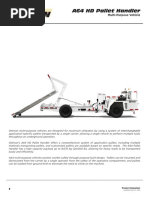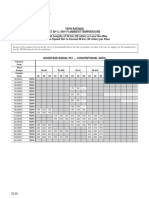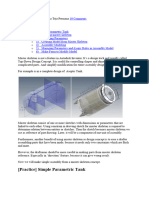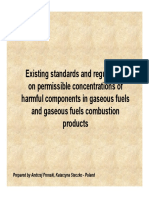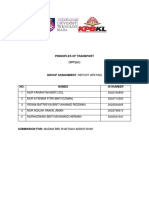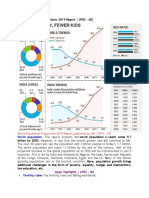Instructions For Spreadsheet Calculations For The Potential To Emit From Stationary Internal Combustion Engines
Uploaded by
Anonymous QiMB2lBCJLInstructions For Spreadsheet Calculations For The Potential To Emit From Stationary Internal Combustion Engines
Uploaded by
Anonymous QiMB2lBCJLInstructions for Spreadsheet Calculations for the Potential to Emit from Stationary Internal Combustion Engines
These spreadsheets are designed to help you determine the potential to emit from gasoline and diesel internal combustion engines using distillate oil, dual fuel, natural gas, or unleaded gasoline. Step 1 Choose one of the worksheets to calculate your emissions. Worksheet 1 calculates emissions based on horsepower-hour and Worksheet 2 calculates emissions based maximum fuel usage/hr and calculates this to million BTU/hr. Step 2 Each of the worksheets has multiple tables with emission factors based on the type of unit you operate. Use the table that corresponds to the type of fuel used and horsepower potential (listed at the top of each table): Table 1 Table 2 Table 3 Table 4 (only on fuel page) Table 4 (or Table 5 on fuel Step 3 Enter the power output (in hp) or maximum hourly fuel usage (in gallons for diesel and gasoline and standard cubic foot for natural gas) in the corresponding highlighted field within the appropriate table as determined above. All tables refering to diesel assume .5% sulfur content. If you are required to use a fuel with a lesser sulfur content, alter the corresponding sulfur content field for Tables 1 or 2 of Worksheet 1. For dual fuel engines, enter the maximum million BTU per hour the unit can burn per the manufacturer's specifications. The potential emissions will then be automatically calculated.
DISCLAIMER: NDEQ does not guarantee the accuracy and is not responsible for errors/omissions in the information contained herin. All calculations are subject to review by NDEQ.
Distillate Oil (Sulfur 0.5%) Distillate Oil (Sulfur 0.5%) Dual Fuel Natural Gas Unleaded Gasoline
< 600 hp > 600 hp
< 250 hp
The calculations are based upon 8,760 hours of operation. If you have an air quality permit that limits your hours of operation, you will have to change the equation in the Emissions (ton/yr) column to reflect that limit. Please note you will have to calculate the emissions for each engine and sum the emissions for each pollutant. This spreadsheet is only set up to calculate one engines emissions per table. Note: The emission factors used in this spreadsheet are generally assumed to be representative of long-term average emission rates and may not accurately represent emissions at your particular facility. The use of more representative emission factors obtained from stack tests or continuous monitoring systems (CEMS) is recommended when available. Contact the Air Quality Division if you have questions regarding the suitability of emission factors for your particular source. Step 4 Save a copy of your maximum potential emission calculations electronically and as a printout. If you need to apply for a permit, please submit a copy of your calculations with your permit application. Please note that if your operations change, you will have to reevaluate if you need an air quality permit. If you have any questions, please call the Air Quality Division at (877) 834-0474 or (402) 471-2189.
DISCLAIMER: NDEQ does not guarantee the accuracy and is not responsible for errors/omissions in the information contained herin. All calculations are subject to review by NDEQ.
For help call the NDEQ 1(877)834-0474 or (402)471-2189
TABLE 1 - Diesel Engine-driven Generators, < 600 hp Fuel: Diesel
Sulfur Content (%) = Heat Content (Btu/gal) = 0.50 137,000
Engine Output: 447 hp Electrical Output : 300 kilowatt [2] Max. Fuel Input : 22.8 gal/hr Emission Factor [3] Emission Factor E.F. Unit Source 2.20E-03 2.20E-03 2.05E-03 0.031 6.68E-03 2.47E-03 1.18E-03 3.87E-03 lb/hp-hr lb/hp-hr lb/hp-hr lb/hp-hr lb/hp-hr lb/hp-hr lb/MMBtu lb/MMBtu Table 3.3-1 Table 3.3-1 Table 3.3-1 Table 3.3-1 Table 3.3-1 Table 3.3-1 Table 3.3-2 Table 3.3-2
[1]
Pollutant PM PM10 SOx NOx CO VOC Individual HAP
(formaldehyde)
[4]
Emission Rate (lb/hr) 0.98 0.98 0.92 13.86 2.99 1.10 0.004 0.01
Emissions (ton/yr) 4.31 4.31 4.01 60.69 13.08 4.84 0.02 0.05
Total HAPs
[1] [2] [3] [4]
Applicable for electrical generator sets, estimated by the equation kW = (hp) * (0.746 kW/hp) * (90% effeciency) Estimated using an average Brake Specific Fuel Consumption (BSFC) of 7,000 Btu/hp-hr AP-42 Section 3.3 - Gasoline & Industrial Diesel Engines (10/96) VOC expressed as total organic compounds
Fuel: Diesel
Sulfur Content (%) = Heat Content (Btu/gal) = 0.50 137,000
TABLE 2 - Diesel Engines & Generators, > 600 hp Engine Output: 600 hp Electrical Output[1]: 403 kilowatt Max. Fuel Input[2]: 30.7 gal/hr Emission Factor Emission Factor E.F. Unit Source[3] 7.0E-04 7.0E-04 4.05E-03 0.024 5.50E-03 6.42E-04 7.76E-04 1.57E-03 lb/hp-hr lb/hp-hr lb/hp-hr lb/hp-hr lb/hp-hr lb/hp-hr lb/MMBtu lb/MMBtu Table 3.4-1 Table 3.4-1 Table 3.4-1 Table 3.4-1 Table 3.4-1 Table 3.4-1 Table 3.4-3 Table 3.4-3
Pollutant PM PM10 SOx NOx CO VOC[4] Individual HAP
(benzene)
Emission Rate (lb/hr) 0.42 0.42 2.43 14.40 3.30 0.38 0.003 0.01
Emissions (ton/yr) 1.84 1.84 10.63 63.07 14.45 1.69 0.01 0.03
Total HAPs
[1] [2] [3] [4]
Applicable for electrical generator sets, estimated by the equation kW = (hp) * (0.746 kW/hp) * (90% effeciency) Estimated using an average Brake Specific Fuel Consumption (BSFC) of 7,000 Btu/hp-hr AP-42 Section 3.4 - Large Stationary Diesel & Dual Fuel Engines (10/96) VOC expressed as total non-methane organic compounds (91% ot TOC)
TABLE 3 - Dual Fuel Engine-driven Generators Fuel: Dual Fuel Pollutant Pma PM10a Soxb NOx CO VOC c Individual HAP
(formaldehyde)
Power Output: Emission Factor Emission Factor (lb/hphr) Source 7.0E-04 7.0E-04 2.99E-04 0.018 7.5E-03 1.32E-03 Table 3.4-1 Table 3.4-1 Table 3.4-1 Table 3.4-1 Table 3.4-1 Table 3.4-1 AP-42 (10/96)
Emission Rate (lb/hr) 0.00 0.00 0.00 0.00 0.00 0.00 -
hp Emissions (ton/yr) 0.00 0.00 0.00 0.00 0.00 0.00 -
Total HAPs
a b c
Used Diesel Fuel Values
Assuming Sulfur % = .5 in fuel oil and Sulfur % = .01 in natural gas Total non-methane VOCs
TABLE 4 - Gasoline Engine-Driven Generators, < 250 hp Power Output: Fuel: Unleaded Gasoline Emission Factor Emission Factor (lb/hphr) Source 7.21E-04 7.21E-04 5.91E-04 0.011 0.44 0.015 Table 3.3-1 Table 3.3-1 Table 3.3-1 Table 3.3-1 Table 3.3-1 Table 3.3-1 AP-42 (10/96)
hp Emissions (ton/yr) 0.00 0.00 0.00 0.00 0.00 0.00 -
Pollutant PM PM10 SOx NOx CO VOC a Total HAPs
a
Emission Rate (lb/hr) 0.00 0.00 0.00 0.00 0.00 0.00 -
Total non-methane VOCs
DISCLAIMER: NDEQ does not guarantee the accuracy and is not responsible for errors/omissions in the information contained herin. All calculations are subject to review by NDEQ.
For help call the NDEQ 1(877)834-0474 or (402)471-2189
TABLE 1 - Diesel Engine-driven Generators, < 600 hp Fuel: Diesel (Sulfur 0.5%) Emission Factor Emission Factor (lb/MMBtu) Source 0.31 Table 3.3-1 Fuel Input: MMBtu/hr
Pollutant PM
Emission Rate (lb/hr) 0.00
Emissions (ton/yr) 0.00
PM10 SOx NOx CO VOC a Individual HAP
(formaldehyde)
0.31 0.29 4.41 0.95 0.35 1.18E-03 3.79E-03
Table 3.3-1 Table 3.3-1 Table 3.3-1 Table 3.3-1 Table 3.3-1 Table 3.3-2 Table 3.3-2
AP-42 (10/96)
0.00 0.00 0.0 0.00 0.00 0.000 0.000
0.00 0.00 0.00 0.00 0.00 0.000 0.000
Total HAPs
a
Total non-methane VOCs
TABLE 2 - Diesel Engine-driven Generators, > 600 hp Fuel: Diesel (Sulfur 0.5%) Emission Pollutant PM PM10 SOx NOx CO VOC Individual HAP
(benzene)
a
Factor 0.07 0.06 0.51 3.2 0.85 8.19E-02 7.76E-04 1.57E-03
Emission Factor Source Table 3.4-2 Table 3.4-2 Table 3.4-1 Table 3.4-1 Table 3.4-1 Table 3.4-1 Table 3.4-3 Table 3.4-3
AP-42 (10/96)
Fuel Input: Emission Rate (lb/hr) 0.00 0.00 0.00 0.00 0.00 0.00 0.00 0.00
MMBtu/hr Emissions (ton/yr) 0.00 0.00 0.00 0.00 0.00 0.00 0.000 0.000
Total HAPs
a
Total non-methane VOCs
TABLE 3 - Dual Fuel Engine-driven Generators Fuel: Dual Fuel Pollutant Pma PM10
a
Emission Factor Emission Factor (lb/MMBtu) Source 0.07 0.06 0.03 2.7 1.16 0.20 7.76E-04 1.57E-03 Table 3.4-2 Table 3.4-2 Table 3.4-1 Table 3.4-1 Table 3.4-1 Table 3.4-1 Table 3.4-3 Table 3.4-3
AP-42 (10/96)
Fuel Input: Emission Rate (lb/hr) 0.00 0.00 0.00 0.00 0.00 0.00 0.000 0.000
MMBtu/hr Emissions (ton/yr) 0.00 0.00 0.00 0.00 0.00 0.00 0.000 0.000
Soxb NOx CO VOC c Individual HAPa
(benzene)
Total HAPsa
a b c
Used Diesel Fuel Values
Assuming Sulfur % = .5 in fuel oil and Sulfur % = .01 in natural gas Total non-methane VOCs
TABLE 4 - Natural Gas Engine-Driven Generators Fuel: Natural Gas Emission Factor Emission Factor (lb/MMBtu) Source 0.048 0.048 5.88E-04 4.08 3.72 0.12 0.055 0.08 Table 3.2-1 Table 3.2-1 Table 3.2-1 Table 3.2-2 Table 3.2-3 Table 3.2-1 Table 3.2-1 Table 3.2-1 Fuel Input: scf/hr 1.0 MMBtu/hr Emissions (ton/yr) Emission Rate (lb/hr) 0.05 0.05 0.001 4.16 3.79 0.12 0.06 0.08 0.22 0.21 0.00 18.23 16.62 0.54 0.25 0.36 1000
Pollutant PM PM10 SOx NOx CO VOC Individual HAP
(formaldehyde)
Total HAPs
Using worst-case emission factors from AP-42 Tables for 2-stroke LB, 4-stroke LB, and 4-stroke RB (07/00)
TABLE 5 - Gasoline Engine-Driven Generators, < 250 hp Fuel: Unleaded Gasoline Emission Factor Emission Factor (lb/MMBtu) Source 0.10 0.10 0.084 1.63 62.7 2.1 Table 3.3-1 Table 3.3-1 Table 3.3-1 Table 3.3-1 Table 3.3-1 Table 3.3-1
AP-42 (10/96)
Fuel Input: Emission Rate (lb/hr) 0.00 0.00 0.00 0.00 0.00 0.00 n/a
Pollutant PM PM10 SOx NOx CO VOC a Total HAPs
a
gallons/hr MMBtu/hr Emissions (ton/yr) 0.00 0.00 0.00 0.00 0.00 0.00 n/a
Total non-methane VOCs
DISCLAIMER: NDEQ does not guarantee the accuracy and is not responsible for errors/omissions in the information contained herin. All calculations are subject to review by NDEQ.
You might also like
- Economic Selection of Surface Mine Haulage OptionsNo ratings yetEconomic Selection of Surface Mine Haulage Options6 pages
- Product News: Lube Oil Consumption of Mannheim Gas GensetsNo ratings yetProduct News: Lube Oil Consumption of Mannheim Gas Gensets3 pages
- High Performance Plastics Materials Guide: Craftech Industries'100% (1)High Performance Plastics Materials Guide: Craftech Industries'20 pages
- Brittle Analysis of Steel Structure in Extremely Cold EnvironmentNo ratings yetBrittle Analysis of Steel Structure in Extremely Cold Environment6 pages
- Diesel Fuel Consumption Turbo Engines PDFNo ratings yetDiesel Fuel Consumption Turbo Engines PDF1 page
- Fuelling Savings in Tough Times: Fuel EconomyNo ratings yetFuelling Savings in Tough Times: Fuel Economy7 pages
- TOWING MASS LIMITS or Vehicle Mass Towing GuideNo ratings yetTOWING MASS LIMITS or Vehicle Mass Towing Guide304 pages
- Reducing Fuel Consumption of Haul Trucks in Surface Mines Using ANo ratings yetReducing Fuel Consumption of Haul Trucks in Surface Mines Using A14 pages
- G460-B8X4 Heavy Tipper: Chassis SpecificationNo ratings yetG460-B8X4 Heavy Tipper: Chassis Specification4 pages
- Powering Load Distribution and Braking oNo ratings yetPowering Load Distribution and Braking o5 pages
- 5.design and Analysis of Fatique Lfe of ImpellerNo ratings yet5.design and Analysis of Fatique Lfe of Impeller50 pages
- Industry Classification Benchmark - Wikipedia, The Free EncyclopediaNo ratings yetIndustry Classification Benchmark - Wikipedia, The Free Encyclopedia5 pages
- 4 Articulo - A System-Wide Approach To Minimize The Operational Cost of Bench Production in Open-Cast Mining OperationsNo ratings yet4 Articulo - A System-Wide Approach To Minimize The Operational Cost of Bench Production in Open-Cast Mining Operations11 pages
- Liebherr Reman Information About General Overhaul enNo ratings yetLiebherr Reman Information About General Overhaul en2 pages
- AMG Daily Service Schedule RTO 12-13 Jan 2022No ratings yetAMG Daily Service Schedule RTO 12-13 Jan 20227 pages
- FC 1124 Tipper: Key Features Key SpecificationsNo ratings yetFC 1124 Tipper: Key Features Key Specifications4 pages
- School of Mines and Mineral Sciences DepNo ratings yetSchool of Mines and Mineral Sciences Dep55 pages
- SANY SKT130S Off-Highway Mining Truck - 160259100% (1)SANY SKT130S Off-Highway Mining Truck - 1602592 pages
- Analysis and Design of Tractor Rear Axle Using Finite Element Method - 52881No ratings yetAnalysis and Design of Tractor Rear Axle Using Finite Element Method - 528815 pages
- Industry Analysis of Autonomous Mine Houl Truck CommercializationNo ratings yetIndustry Analysis of Autonomous Mine Houl Truck Commercialization89 pages
- Reducing The Soot in Diesel Engines: Fuel Oil Additives Fuel Oil AdditivesNo ratings yetReducing The Soot in Diesel Engines: Fuel Oil Additives Fuel Oil Additives7 pages
- Antennas Inside An Automobile: Gps/Glonass Digital Audio Digital TV Sirius RadioNo ratings yetAntennas Inside An Automobile: Gps/Glonass Digital Audio Digital TV Sirius Radio2 pages
- 14264A Construction Mechanic Basic Chapters 11 PDFNo ratings yet14264A Construction Mechanic Basic Chapters 11 PDF44 pages
- The Nikon Guide To Landscape Photography - 2014 UKNo ratings yetThe Nikon Guide To Landscape Photography - 2014 UK162 pages
- Energy Conversion 1.1 - Demo Version: Engineering SoftwareNo ratings yetEnergy Conversion 1.1 - Demo Version: Engineering Software36 pages
- Control of Air Pollution in Car Parks PDFNo ratings yetControl of Air Pollution in Car Parks PDF7 pages
- OSHAD-SF - Glossary of Terms v3.0 - English Copy (Full Permission)No ratings yetOSHAD-SF - Glossary of Terms v3.0 - English Copy (Full Permission)40 pages
- Well To Wheel Analysis of Greenhouse Gas Emissions For Electric Vehicles Based On Electricity Generation Mix A Global PerspectiveNo ratings yetWell To Wheel Analysis of Greenhouse Gas Emissions For Electric Vehicles Based On Electricity Generation Mix A Global Perspective31 pages
- Ports & Terminals in India - Lexology PDFNo ratings yetPorts & Terminals in India - Lexology PDF11 pages
- Name: Nola Aulia Tasya NIM: 2010914120023 Class: A Deapartement Of: PsychologyNo ratings yetName: Nola Aulia Tasya NIM: 2010914120023 Class: A Deapartement Of: Psychology5 pages
- G. Demystifying Air Pollution in London - Mož Uvod Source I Mean Air PollNo ratings yetG. Demystifying Air Pollution in London - Mož Uvod Source I Mean Air Poll40 pages
- Presidential Decree No. 1152 Philippine Environment CodeNo ratings yetPresidential Decree No. 1152 Philippine Environment Code13 pages
- World Population Projections 2019 ReportNo ratings yetWorld Population Projections 2019 Report30 pages
- Economic Selection of Surface Mine Haulage OptionsEconomic Selection of Surface Mine Haulage Options
- Product News: Lube Oil Consumption of Mannheim Gas GensetsProduct News: Lube Oil Consumption of Mannheim Gas Gensets
- High Performance Plastics Materials Guide: Craftech Industries'High Performance Plastics Materials Guide: Craftech Industries'
- Brittle Analysis of Steel Structure in Extremely Cold EnvironmentBrittle Analysis of Steel Structure in Extremely Cold Environment
- Reducing Fuel Consumption of Haul Trucks in Surface Mines Using AReducing Fuel Consumption of Haul Trucks in Surface Mines Using A
- Industry Classification Benchmark - Wikipedia, The Free EncyclopediaIndustry Classification Benchmark - Wikipedia, The Free Encyclopedia
- 4 Articulo - A System-Wide Approach To Minimize The Operational Cost of Bench Production in Open-Cast Mining Operations4 Articulo - A System-Wide Approach To Minimize The Operational Cost of Bench Production in Open-Cast Mining Operations
- Liebherr Reman Information About General Overhaul enLiebherr Reman Information About General Overhaul en
- Analysis and Design of Tractor Rear Axle Using Finite Element Method - 52881Analysis and Design of Tractor Rear Axle Using Finite Element Method - 52881
- Industry Analysis of Autonomous Mine Houl Truck CommercializationIndustry Analysis of Autonomous Mine Houl Truck Commercialization
- Modular Mining Systems The Ultimate Step-By-Step GuideFrom EverandModular Mining Systems The Ultimate Step-By-Step Guide
- Reducing The Soot in Diesel Engines: Fuel Oil Additives Fuel Oil AdditivesReducing The Soot in Diesel Engines: Fuel Oil Additives Fuel Oil Additives
- Antennas Inside An Automobile: Gps/Glonass Digital Audio Digital TV Sirius RadioAntennas Inside An Automobile: Gps/Glonass Digital Audio Digital TV Sirius Radio
- 14264A Construction Mechanic Basic Chapters 11 PDF14264A Construction Mechanic Basic Chapters 11 PDF
- The Nikon Guide To Landscape Photography - 2014 UKThe Nikon Guide To Landscape Photography - 2014 UK
- Energy Conversion 1.1 - Demo Version: Engineering SoftwareEnergy Conversion 1.1 - Demo Version: Engineering Software
- OSHAD-SF - Glossary of Terms v3.0 - English Copy (Full Permission)OSHAD-SF - Glossary of Terms v3.0 - English Copy (Full Permission)
- Well To Wheel Analysis of Greenhouse Gas Emissions For Electric Vehicles Based On Electricity Generation Mix A Global PerspectiveWell To Wheel Analysis of Greenhouse Gas Emissions For Electric Vehicles Based On Electricity Generation Mix A Global Perspective
- Name: Nola Aulia Tasya NIM: 2010914120023 Class: A Deapartement Of: PsychologyName: Nola Aulia Tasya NIM: 2010914120023 Class: A Deapartement Of: Psychology
- G. Demystifying Air Pollution in London - Mož Uvod Source I Mean Air PollG. Demystifying Air Pollution in London - Mož Uvod Source I Mean Air Poll
- Presidential Decree No. 1152 Philippine Environment CodePresidential Decree No. 1152 Philippine Environment Code







